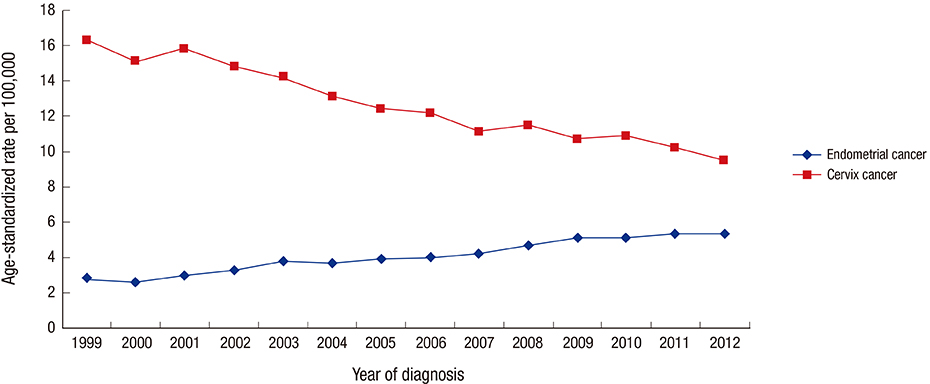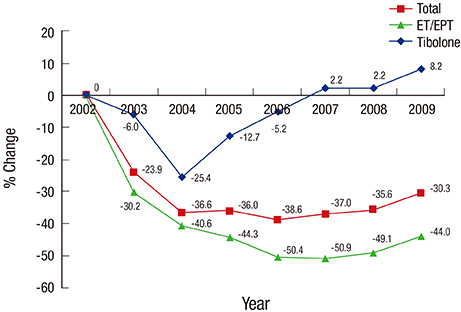J Korean Med Sci.
2017 May;32(5):830-834. 10.3346/jkms.2017.32.5.830.
Common Causes of Postmenopausal Bleeding in Korean Women: 10-Year Outcomes from a Single Medical Center
- Affiliations
-
- 1Department of Obstetrics and Gynecology, Severance Hospital, Yonsei University College of Medicine, Seoul, Korea. tudeolseo@yuhs.ac
- 2Institute of Women's Life Medical Science, Yonsei University College of Medicine, Seoul, Korea.
- 3Department of Obstetrics and Gynecology, Wonju Severance Christian Hospital, Yonsei University Wonju College of Medicine, Wonju, Korea.
- 4Department of Obstetrics and Gynecology, Gil Hospital, Gachon University College of Medicine, Incheon, Korea.
- 5Department of Obstetrics and Gynecology, Gangnam Severance Hospital, Yonsei University College of Medicine, Seoul, Korea.
- KMID: 2375085
- DOI: http://doi.org/10.3346/jkms.2017.32.5.830
Abstract
- The common causes of postmenopausal bleeding (PMB), according to the data from the western world, are atrophy, hormone replacement therapy (HRT), endometrial cancer, etc. We conducted a retrospective study to assess whether the causes of PMB in Korean postmenopausal women are similar to those already known. This retrospective study used 10-year medical records (March 2005 to December 2014) of 792 PMB women in the Yonsei University Health System. The data were divided into 2 categories by 5-year intervals to compare the differences between the 2 periods. The most common cause of PMB in Korean women was atrophy (51.1%). Polyps and HRT were the second, followed by anticoagulant medications, cervical cancer, and endometrial cancer. The proportion of patients with cervical cancer significantly decreased during the second half of the decade (8.7% vs. 5.2%; P = 0.048). Although no significant change was noted for HRT, its rank was higher during the latter 5-year period. Only the most common cause of PMB was the same as the conventional data. Interestingly, the proportion of patients with cervical cancer decreased during the latter half of the decade, reflecting the changes in the nation's cancer prevalence rate, while the use of HRT increased.
Keyword
MeSH Terms
Figure
Cited by 1 articles
-
Reproductive Life Span and Severe Hypoglycemia Risk in Postmenopausal Women with Type 2 Diabetes Mellitus
Soyeon Kang, Yong-Moon Park, Dong Jin Kwon, Youn-Jee Chung, Jeong Namkung, Kyungdo Han, Seung-Hyun Ko
Diabetes Metab J. 2022;46(4):578-591. doi: 10.4093/dmj.2021.0135.
Reference
-
1. Breijer MC, Mol BW. Transvaginal ultrasound measurement of the endometrium remains the first line test for investigating postmenopausal bleeding but integration of patient characteristics into testing may further improve diagnostic algorithms. BJOG. 2016; 123:447.2. Salman MC, Bozdag G, Dogan S, Yuce K. Role of postmenopausal bleeding pattern and women’s age in the prediction of endometrial cancer. Aust N Z J Obstet Gynaecol. 2013; 53:484–488.3. Wong AS, Lao TT, Cheung CW, Yeung SW, Fan HL, Ng PS, Yuen PM, Sahota DS. Reappraisal of endometrial thickness for the detection of endometrial cancer in postmenopausal bleeding: a retrospective cohort study. BJOG. 2016; 123:439–446.4. Dueholm M, Marinovskij E, Hansen ES, Møller C, Ørtoft G. Diagnostic methods for fast-track identification of endometrial cancer in women with postmenopausal bleeding and endometrial thickness greater than 5 mm. Menopause. 2015; 22:616–626.5. Smith PP, O’Connor S, Gupta J, Clark TJ. Recurrent postmenopausal bleeding: a prospective cohort study. J Minim Invasive Gynecol. 2014; 21:799–803.6. Izetbegovic S, Stojkanovic G, Ribic N, Mehmedbasic E. Features of postmenopausal uterine haemorrhage. Med Arh. 2013; 67:431–434.7. Loiacono RM, Trojano G, Del Gaudio N, Kardhashi A, Deliso MA, Falco G, Sforza R, Laera AF, Galise I, Trojano V. Hysteroscopy as a valid tool for endometrial pathology in patients with postmenopausal bleeding or asymptomatic patients with a thickened endometrium: hysteroscopic and histological results. Gynecol Obstet Invest. 2015; 79:210–216.8. Dueholm M, Hjorth IM, Secher P, Jørgensen A, Ørtoft G. Structured hysteroscopic evaluation of endometrium in women with postmenopausal bleeding. J Minim Invasive Gynecol. 2015; 22:1215–1224.9. Breijer MC, van Hanegem N, Visser NC, Verheijen RH, Mol BW, Pijnenborg JM, Opmeer BC, Timmermans A. Does probability guided hysteroscopy reduce costs in women investigated for postmenopausal bleeding. ScientificWorldJournal. 2015; 2015:605312.10. Cavkaytar S, Kokanali MK, Ceran U, Topcu HO, Sirvan L, Doganay M. Roles of sonography and hysteroscopy in the detection of premalignant and malignant polyps in women presenting with postmenopausal bleeding and thickened endometrium. Asian Pac J Cancer Prev. 2014; 15:5355–5358.11. Park Y, Vongdala C, Kim J, Ki M. Changing trends in the incidence (1999–2011) and mortality (1983–2013) of cervical cancer in the Republic of Korea. Epidemiol Health. 2015; 37:e2015024.12. Jung KW, Won YJ, Kong HJ, Oh CM, Cho H, Lee DH, Lee KH. Cancer statistics in Korea: incidence, mortality, survival, and prevalence in 2012. Cancer Res Treat. 2015; 47:127–141.13. Lim MC, Moon EK, Shin A, Jung KW, Won YJ, Seo SS, Kang S, Kim JW, Kim JY, Park SY. Incidence of cervical, endometrial, and ovarian cancer in Korea, 1999–2010. J Gynecol Oncol. 2013; 24:298–302.14. Shin MH, Oh HK, Ahn YO. Ten year trend of cancer incidence in Seoul, Korea: 1993--2002. J Prev Med Public Health. 2008; 41:92–99.15. Berek JS, Novak E. Berek & Novak's Gynecology. 15th ed. Philadelphia, PA: Wolters Kluwer Health/Lippincott Williams & Wilkins;2012.16. Fritz MA, Speroff L. Clinical Gynecologic Endocrinology and Infertility. 8th ed. Philadelphia, PA: Wolters Kluwer Health/Lippincott Williams & Wilkins;2011.17. Moodley M, Roberts C. Clinical pathway for the evaluation of postmenopausal bleeding with an emphasis on endometrial cancer detection. J Obstet Gynaecol. 2004; 24:736–741.18. Dueholm M, Hjorth IM, Secher P, Jørgensen A, Ørtoft G. Reproducibility of endometrial pathologic findings obtained on hysteroscopy, transvaginal sonography, and gel infusion sonography in women with postmenopausal bleeding. J Minim Invasive Gynecol. 2015; 22:1036–1044.19. Oh CM, Jung KW, Won YJ, Shin A, Kong HJ, Jun JK, Park SY. Trends in the incidence of in situ and invasive cervical cancer by age group and histological type in Korea from 1993 to 2009. PLoS One. 2013; 8:e72012.20. Kyvernitakis I, Kostev K, Hars O, Albert US, Hadji P. Discontinuation rates of menopausal hormone therapy among postmenopausal women in the post-WHI study era. Climacteric. 2015; 18:737–742.21. Kim JY, Sang JH, Park HM. The change of hormone therapy in postmenopausal women in Korea before and after women’s health initiative study: 2000–2009. Korean J Obstet Gynecol. 2010; 53:1110–1117.22. Cummings SR, Ettinger B, Delmas PD, Kenemans P, Stathopoulos V, Verweij P, Mol-Arts M, Kloosterboer L, Mosca L, Christiansen C, et al. The effects of tibolone in older postmenopausal women. N Engl J Med. 2008; 359:697–708.23. Hammar ML, van de Weijer P, Franke HR, Pornel B, von Mauw EM, Nijland EA; TOTAL Study Investigators Group. Tibolone and low-dose continuous combined hormone treatment: vaginal bleeding pattern, efficacy and tolerability. BJOG. 2007; 114:1522–1529.
- Full Text Links
- Actions
-
Cited
- CITED
-
- Close
- Share
- Similar articles
-
- The Correlation between the Endometrial Cancer and Postmenopausal Uterine Bleeding
- Hematometra Due to Cervical Stenosis in a Postmenopausal Woman with Incidental Ovarian Steroid Cell Tumor: A Case Report
- Uterine bleeding in a postmenopausal women following epidural triamcinolone acetonide injection: A case report
- Changes of bone mineral density after 2-yrs treatment with HRT and alendronate in osteoporotic Korean women
- The Mediating Effect of Attitudes Towards Senility and Death on the Relationship Between Marital Satisfaction and Depression in Presenile Postmenopausal Women




